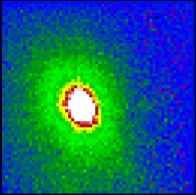
 53.2KB
53.2KB
 34.7KB
34.7KB
Observers: Hans-Ulrich Kaeufl, Yan Fernandez
Location: European Southern Observatory, La Silla, Chile
Date: July 19, 1997 13:39, 14:58 UT

 53.2KB
53.2KB
 34.7KB
34.7KB
Observers: Hans-Ulrich Kaeufl, Yan Fernandez
Location: European Southern Observatory, La Silla, Chile
Date: July 19, 1997 13:39, 14:58 UT
Following the perihelion passage on April 1, 1997, Comet Hale-Bopp has moved southwards and also closer to the Sun, as seen in the sky. During a period of about two months (mid-May to mid-July), it has been virtually impossible to obtain conventional images with optical detectors.
Now, however, Hans-Ulrich Kaeufl (ESO) and Yan Fernandez (Univ. of Maryland, USA) have succeeded in taking the first mid-infrared images after the perihelion passage from the ESO La Silla Observatory, by means of the TIMMI (Thermal Infrared MultiMode Instrument) at the ESO 3.6-m telescope.
These images were obtained during a daytime observing session when the comet was only 31o from the Sun in the sky. This is about as close as one can observe with this instrumental combination. The images have not yet been studied in detail and a scientific evaluation is yet to follow.
At that time, the comet was `behind' the Sun, at a heliocentric distance of 2.785 AU (417 million km) and it was seen almost `head-on'; the Sun-comet-Earth angle (the phase) was only 15o.
Two frames, both measuring 64x64 pixels, are shown here in false-colour reproductions:
1. 10.3-13.0 micron image with .45/arcsec/pix obtained on 1997 July 19 at 13:38:34 UT (local time at La Silla was 08:38 in the morning). The radiation in this waveband is mostly thermal emission from the dust (i.e., the continuum outside the Silicate emission feature). The field measures 29x29 arcsec2; North is up and East is to the left.
2. 9.1-10.4 micron image with .66 arcsec/pix obtained on 1997 July 19 at 14:57:49 UT (local time at La Silla was 09:57 in the morning). The radiation in this waveband is mostly emission from silicate grains (the `silicate feature'). The field measures 42x42 arcsec2; North is up and East is to the left.
These two frames are representative for a sample of approximately 25 observations done during a period of 5 days (not nights!) following the end of normal night observing. The purpose of these observations was:
 Get your own Free Web Page
Get your own Free Web Page